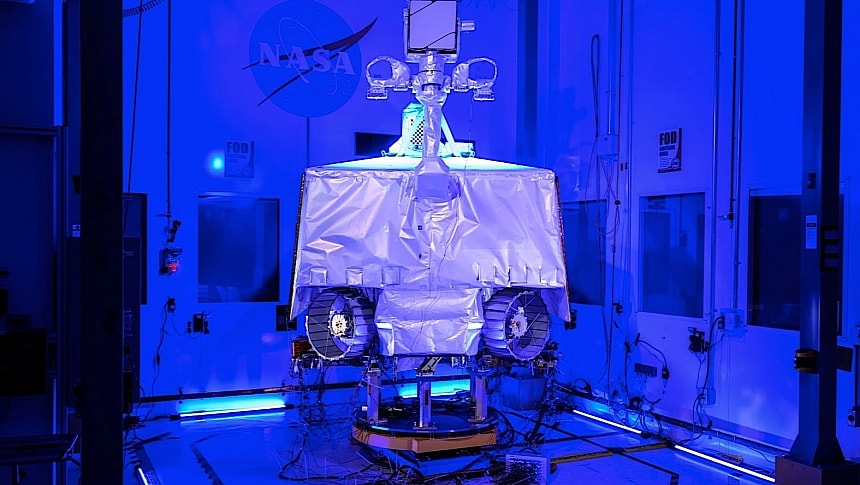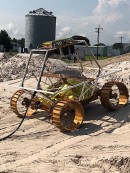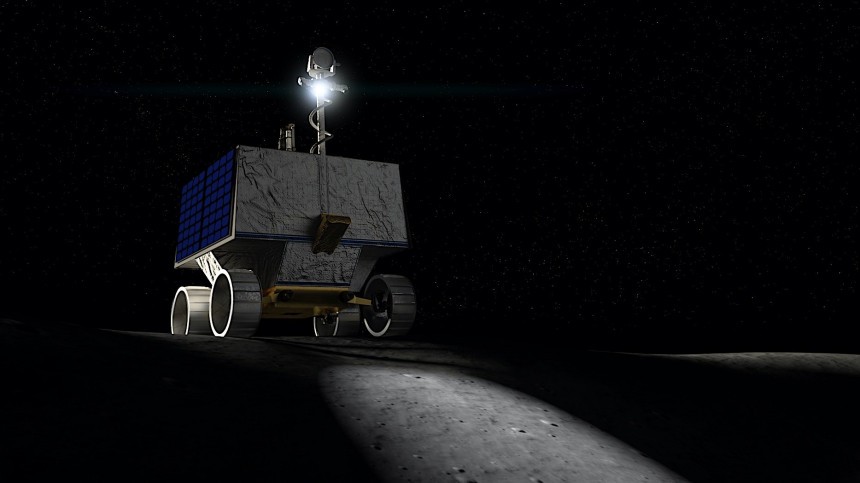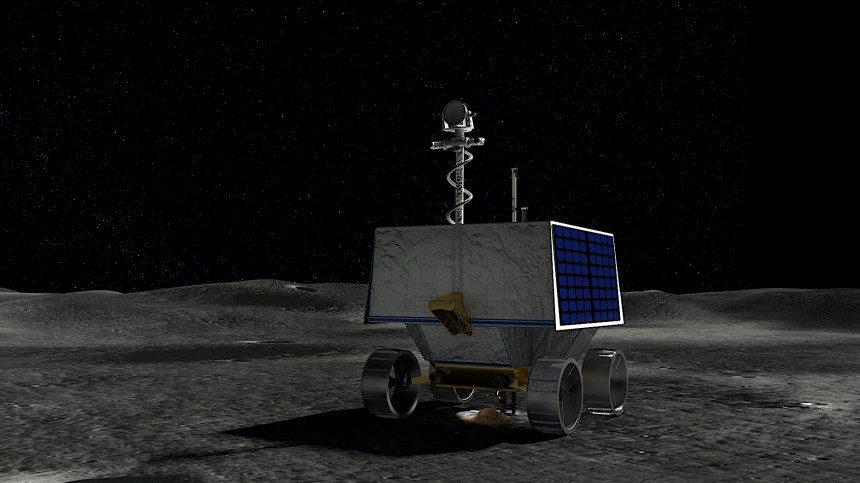NASA and its partners' new Moon exploration program have a huge number of missions planned, many of them interconnected and working toward the common goal of allowing humanity to create a base of operations up there. Some of these missions have already proven their worth, others are in advanced stages of development, but few, despite their importance and the resources that went into them, get scrapped.
Over the past few years, we've talked quite a bit about a robot rover called the Volatiles Investigating Polar Exploration Rover (VIPER). That would be not only America's first robotic rover meant to explore the Moon but also the country's first one dedicated to the search for water.
Not taking into account what happened this week (I'll get to that in a bit), the last we heard something important about the machine was back in April, when NASA announced it got the rover to raise its mast. At the time, everything seemed to be going according to plan, and nothing seemed to preview the rather shocking announcement the space agency made on Wednesday, July 17.
In a nutshell, the VIPER rover is canceled, with no hope of it actually being revived.
NASA said it conducted a "comprehensive internal review" of the mission and decided it was simply not worth it. That's because the VIPER's launch date has been constantly delayed, and the cost of keeping it on track is becoming increasingly hard to bear. It is estimated the agency has already burned through almost half a billion dollars for this project.
The VIPER has been in the works for some time now, and it is part of the Commercial Lunar Payload Services (CLPS) program that enlists the support of private companies for major space missions. A SpaceX Falcon Heavy rocket was supposed to get it off the ground, and a lander called Griffin, made by Astrobotic, was supposed to bring it to the surface of the Moon.
The rover's initial launch date was late 2023, but at Astrobotic's request, which needed more time to prepare its lander, the date was pushed to late 2024. Because of undisclosed "schedule and supply chain delays," NASA says it would have been unable to get the mission going before September 2025.
That would not only have incurred increased costs but also interfered with other missions of the CLPS program. Hence, the VIPER is now dead.
I said earlier that there is no chance for the VIPER to be revived. Scrapped space missions have a tendency to be revived once funding is found, but that's not what will happen with this rover. Instead, NASA will dismantle it and reuse its component parts for future missions to the planet's satellite.
Before getting to work to chop up the machine, the agency said it is waiting for interested parties in the industry to express interest in using the rover's component parts. The window for this to happen is, however, rather small, as it will close on August 1.
So, what could one repurpose from the VIPER?
The rover is a four-wheeled contraption that looks more or less like a cube with a mast on top. It measures 5 feet by 5 feet by 8 feet (1.5 meters by 1.5 meters by 2.5 meters) and weighs 992 pounds (450 kilograms).
VIPER's power source is a solar-charged battery rated at 450 watts peak power. It is equipped with a 3.28-foot (1-meter) drill which it was supposed to use to dig for water into the surface of the Moon.
The eight-foot (2.5 meters) mast is where the vehicle houses a pair of stereo navigation cameras and a pair of antennas. Headlights, a first for a rover meant for the exploration of another world, are also included, and they should have allowed the VIPER to see better in the permanently shadowed craters it would have traveled.
The rover has four main instruments. The Neutron Spectrometer System (NSS) was supposed to detect the presence of water in the soil, the Regolith and Ice Drill for Exploring New Terrains (TRIDENT) was to be used to dig up soil cuttings, and the Near-Infrared Volatiles Spectrometer System (NIRVSS) was to analyze the samples. Finally, the Mass Spectrometer Observing Lunar Operations (MSolo) is the tool the rover would have used to assess gases in the environment.
All these four instruments, but also copies of them, will be deployed on future Moon missions that directly or indirectly target Moon water, a crucial element for the success of the upcoming human presence there.
VIPER's role in finding water will be taken not by one but by several pieces of hardware over the next five years. Later in 2024, for instance, NASA plans to launch something called the Polar Resources Ice Mining Experiment-1 (PRIME-1). Developed by Honeybee Robotics, it carries the TRIDENT and Msolo - it will not be as mobile as the rover would have been, but it is expected to get the job done.
Even the Lunar Terrain Vehicle currently being developed for the later crewed Artemis missions will be equipped with tools that should allow it to detect water.
As for the Griffin lander that was supposed to deliver the VIPER, NASA says that one is still a go, but it will only be used to demo the lander itself and its engines.
Not taking into account what happened this week (I'll get to that in a bit), the last we heard something important about the machine was back in April, when NASA announced it got the rover to raise its mast. At the time, everything seemed to be going according to plan, and nothing seemed to preview the rather shocking announcement the space agency made on Wednesday, July 17.
In a nutshell, the VIPER rover is canceled, with no hope of it actually being revived.
NASA said it conducted a "comprehensive internal review" of the mission and decided it was simply not worth it. That's because the VIPER's launch date has been constantly delayed, and the cost of keeping it on track is becoming increasingly hard to bear. It is estimated the agency has already burned through almost half a billion dollars for this project.
The VIPER has been in the works for some time now, and it is part of the Commercial Lunar Payload Services (CLPS) program that enlists the support of private companies for major space missions. A SpaceX Falcon Heavy rocket was supposed to get it off the ground, and a lander called Griffin, made by Astrobotic, was supposed to bring it to the surface of the Moon.
The rover's initial launch date was late 2023, but at Astrobotic's request, which needed more time to prepare its lander, the date was pushed to late 2024. Because of undisclosed "schedule and supply chain delays," NASA says it would have been unable to get the mission going before September 2025.
I said earlier that there is no chance for the VIPER to be revived. Scrapped space missions have a tendency to be revived once funding is found, but that's not what will happen with this rover. Instead, NASA will dismantle it and reuse its component parts for future missions to the planet's satellite.
Before getting to work to chop up the machine, the agency said it is waiting for interested parties in the industry to express interest in using the rover's component parts. The window for this to happen is, however, rather small, as it will close on August 1.
So, what could one repurpose from the VIPER?
The rover is a four-wheeled contraption that looks more or less like a cube with a mast on top. It measures 5 feet by 5 feet by 8 feet (1.5 meters by 1.5 meters by 2.5 meters) and weighs 992 pounds (450 kilograms).
VIPER's power source is a solar-charged battery rated at 450 watts peak power. It is equipped with a 3.28-foot (1-meter) drill which it was supposed to use to dig for water into the surface of the Moon.
The eight-foot (2.5 meters) mast is where the vehicle houses a pair of stereo navigation cameras and a pair of antennas. Headlights, a first for a rover meant for the exploration of another world, are also included, and they should have allowed the VIPER to see better in the permanently shadowed craters it would have traveled.
All these four instruments, but also copies of them, will be deployed on future Moon missions that directly or indirectly target Moon water, a crucial element for the success of the upcoming human presence there.
VIPER's role in finding water will be taken not by one but by several pieces of hardware over the next five years. Later in 2024, for instance, NASA plans to launch something called the Polar Resources Ice Mining Experiment-1 (PRIME-1). Developed by Honeybee Robotics, it carries the TRIDENT and Msolo - it will not be as mobile as the rover would have been, but it is expected to get the job done.
Even the Lunar Terrain Vehicle currently being developed for the later crewed Artemis missions will be equipped with tools that should allow it to detect water.
As for the Griffin lander that was supposed to deliver the VIPER, NASA says that one is still a go, but it will only be used to demo the lander itself and its engines.





















